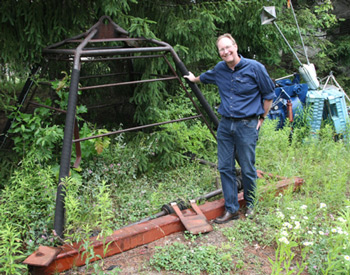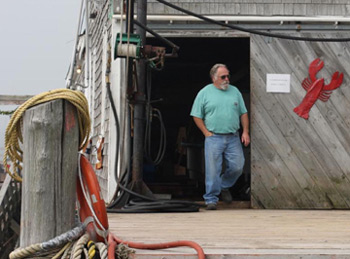FISHERMEN ON FISHING
Science, Information and Collaboration
by Sam Murfitt

Kevin Stokesbury is a marine scientist at the School for Marine Science and Technology in South Dartmouth, MA.He has designed and engineered equipment that assesses scallop stocks in real time via video. He is seen here outside his lab with some the equipment he has built. ©Photo by Sam Murfitt
We work closely with the scallop fishery. The latest example of our work with the scallop fishery is they're helping us develop a video survey and it’s been very successful. What that video survey did was estimate the number of scallops on the sea floor accurately. Before that it was a relative estimate achieved by a dredge. The problem with that method is you never know how much is collected in the dredge removed. The video survey removed a lot of the uncertainty by actually allowing us to see the sea floor and count the scallops.
The way the management plan is now run is with a series of rotationals. There are some days, rotational fisheries. Each vessel can go in the open area for a certain amount of time and they also have a number of harvest trips from these closed areas. In the winter we have a fishermen’s steering committee that meets with us about every month. They raised a real concern about this opening. They were concerned that there wasn’t enough yellowtail bycatch allocated for the scallop harvest.
In the past. in many of these areas they have closed early or they have been closed without reaching their harvestable number of scallops, because of the yellowtail bycatch. In closed area two, the last time in the Nantucket Lightship area it was a terrible situation. Less than half the fleet got their allotted catch and so some people will talk to you and say “Oh, well, we let them go out in the open area and make up days,” but it’s not as much, it’s not comparable. It’s not the same kind of thing and those animals aren’t money in the bank. They don’t live forever. If you you don’t go in and get them, your going to lose them. We have filmed mass mortalities in this area in the past.
So we looked at some of the examples by John Gavin and I’ve put a couple of very good PhD students on the project. In a series of meetings with the fishermen, they came up with a grid pattern based on Loran C in this area. We also worked with Bill DuPaul from the Virginia Institute of Marine Science. A group there had done a survey last year in 2009. It showed where the yellowtailed bycatch was and showed where they caught scallops in their commercial dredge.
That information was sent to the entire fishing industry. We then went out and did our video survey with the fishing fleet. We sent a second letter in 2010 saying this is specifically where we saw scallops. So providing the information on where we thought the yellowtail were and where we were pretty sure the scallops were.
We then set up a system so that fishermen using boat tracs could email us back. We worked on what would be a low medium or high. Based on a signal light, green for “ok”, red for “stay out of it” and yellow for “be cautious”. Based on the threshold, we estimated what by-catch it would take to close the fishery, which worked out to be about one pound for every fifty-six or fifty-three pounds of scallops. Fifty-three pounds of scallops to one-pound of yellow tail.
That worked out to about ten pounds per tow – so when the fishermen were getting about ten pounds per tow they – what they would do is tell us we’ve done so many tows in this cell and on average we caught five pounds per tow or we caught ten pounds or we caught fifteen pounds. They would email us this throughout the day and at 8:00 we’d stop the emails, we’d compile the information and we’d check the map and we’d see what areas were hot spots, what we’re calling red areas, what were cautious areas and what were green and we sent that back to the fishery.
Usually in a fishery in a closed area by-catch increases over time, but in this example it actually decreased. We started getting that information back to fisherman, they stayed away from the hot spots, we put it up on the internet, maps up on the website, like the SMAST website, to let as many people as possible know. Some of the fishermen we worked with closely actually called out on the radio and let everyone know where to stay away from.
The result was that the fishery was successful and most of the boats had completed their trips and less than 20 percent of the bycatch has been caught. So it was a complete shift from what happened two years ago in this same area where it was closed down with less than half the fleet taking their trips.
That’s an example of there being a lot of smart people in this fishery, and a lot of good will. As long as they're informed, given timely information, and the effort is made to get the information out there, people will take advantage of it and it can work.
Consolidation is the Problem
by Sam Murfitt

Gary Hatch of Rockland, Maine, is a multi permit holder who fishes scallops. ©Photo by Sam Murfitt
Well, with the general category it’s pretty well wiped out. The intention of Amendment 4 as far as the state of Maine goes– now they’ve given us the general category State of Maine guides, the 200 pounds versus what initially started out at 400. For the few that did qualify for any quota through the new consolidation efforts, they didn’t get anywhere near their contributing factors as far as the weight that they contributed to be qualified.
Therefore the biggest thing that’s happened in the general category is that companies bought bigger boats because of the new split in the general category. For west to 7230 there were no restrictions on boat sizes. East of it was restricted to the largest regulation in the state of Maine, which is the 10 foot drag. Consequently, there are guys to the west of that number who are prepared to pay larger amounts of money for quota.
So the guys here are selling their quota to those guys. The whole community suffers because there’s no fishery here now. And the biggest problem is the employment for the young guys, because scalloping is a young guy fishery, so to speak. They're out of business, out of work, and they're not getting to develop their skills to move on. And of course there’s nothing to move on to. With the way it’s set up, a young fellow trying to own his own boat and trying to fish it, needs five or six hundred thousand dollars to buy the boat and enough quota to pay for it. So basically they’ve taken the small players right out of it.
For us guys, who are in limited access, we’re fighting changes to that right now. Management’s trying to move on what they’re considering excess capacity. But they’re in violation, as far as I’m concerned, with National Standard 5 because it’s not up to the National Marine Fisheries Service to manage fisheries based on finances. It’s supposed to manage fisheries per the resource.
What’s driving this is the so-called, five large players. Nobody’s come forth and quantified who they are in their permits, but (attorney) Jeff Pike, who represents them at the New England Fisheries Management Council, claims that there are 100 permits. They want this capacity reduction very badly because they can build four or five super boats and do away with all their old boats.
Of course, when they do that they’ll take up the capacity in the fishery. That will have the same effect as it did in the general category. It will take the quota or the total allowable catch to the point where the small independent fishermen won’t have enough quota to fish. Small independent fishermen will be so overtaken by the large companies that we’ll end up with 30 days fishing, total, and of course we can’t stay in business with that little. We can’t survive with that and no one of us will be in any position to buy any quota should they go to a quota based allocation. It’s consolidation and that’s how they’ve written it.
Steve Ouellette, the lawyer from Gloucester who is representing the majority of us, well over 100 permit holders, is presenting the case that we don’t need this capacity reduction. There’s no overfishing, the overfishing’s not occurring and it’s a healthy fishery. So why should a healthy fishery be taken away from the many and be given to a conglomerate of a few? It makes no sense to me. The new head of NOAA, Jane Lubchenco, has this mighty idea that this is the best thing since sliced bread, and she’s in the position and has the backing from the environmental groups, to push it through. Push it through and do away with the small coastal community fisheries that have always thrived in New England.
